Vibrant geranium flowers are favorites of home gardeners, adding color to window boxes, borders, and beds.
There are three types: the hardy cranesbill (Geranium spp.), the hanging ivy type (Pelargonium peltatum), and the garden geranium (Pelargonium x hortorum).
In this brief article, we zero in on how to start new plants by taking stem cuttings from existing ones.
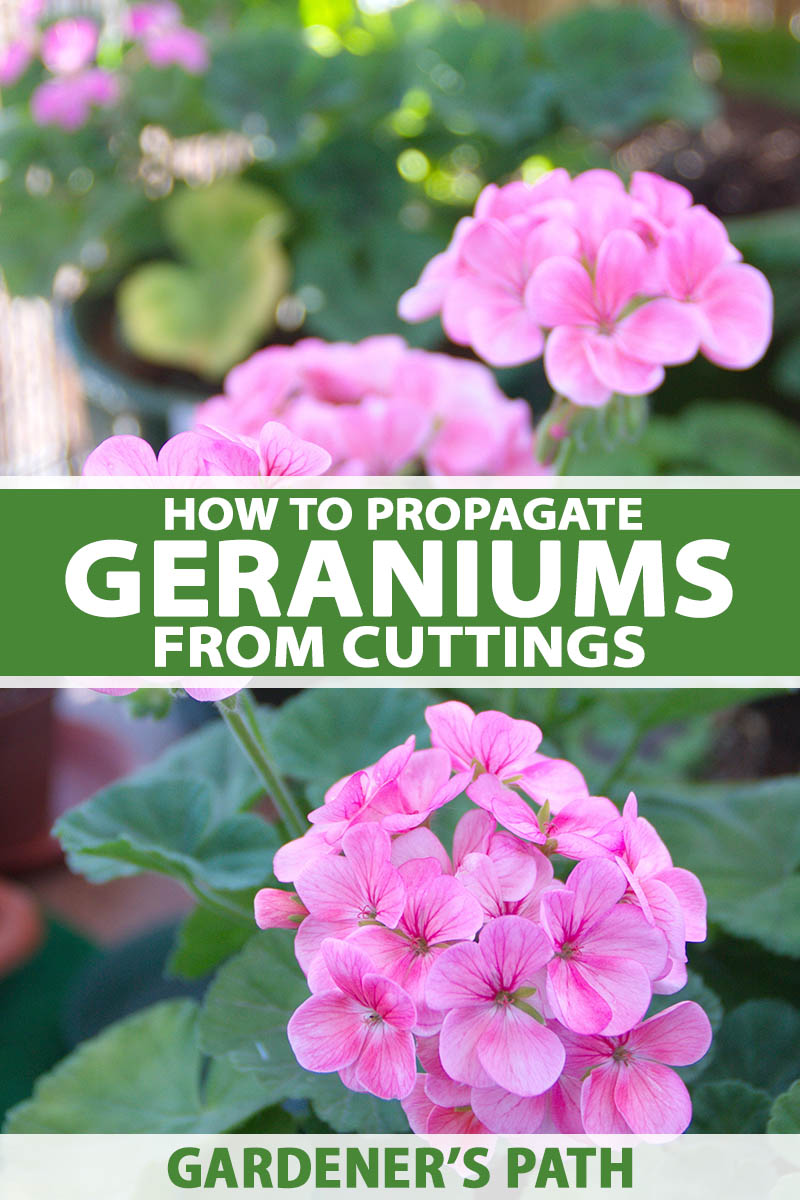
We link to vendors to help you find relevant products. If you buy from one of our links, we may earn a commission.
Here’s what’s in store:
What You’ll Learn
Read on to learn how easy it is.
Preparing a Stem Cutting
The best time to take a cutting is when a plant has a flush of new growth, and before it sets buds, at any time during the growing season.
If you are growing garden geraniums as annuals, taking cuttings in fall before the plants fade means you’ll have fresh new ones to plant out in spring.
Here’s how to do it:
Choose a sturdy stem with healthy leaves. Try to avoid the flimsy newest growth and the older, woodiest stems, as well as any with discolored or damaged foliage.
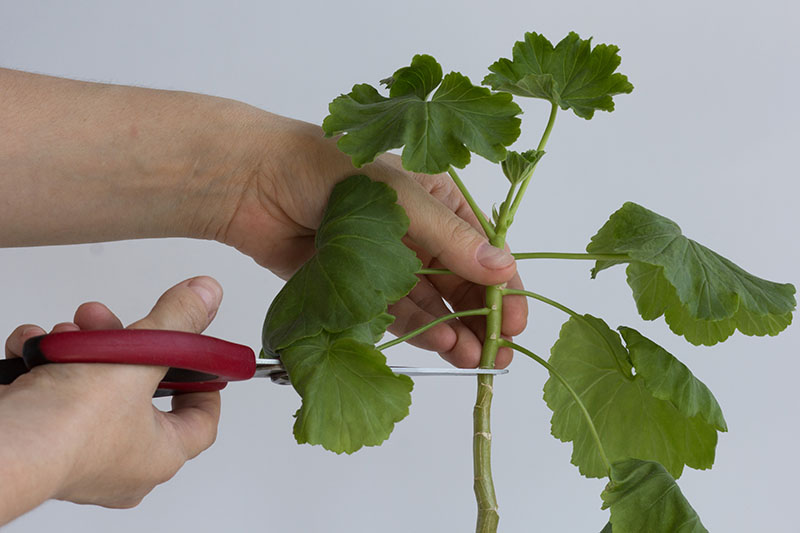
Use clean, sharp pruners, or a fine blade to slice through a stem.
Make the cut just below a leaf node and four to six inches down from the stem tip.

Snip off the lower foliage, leaving two or three leaves at the top, so you have three to four inches of bare stem. Remove any flower or leaf buds, as they might direct energy away from root formation.
Rooting Stems in Water
Place the stem in a clean, clear glass or jar that is four to six inches deep.
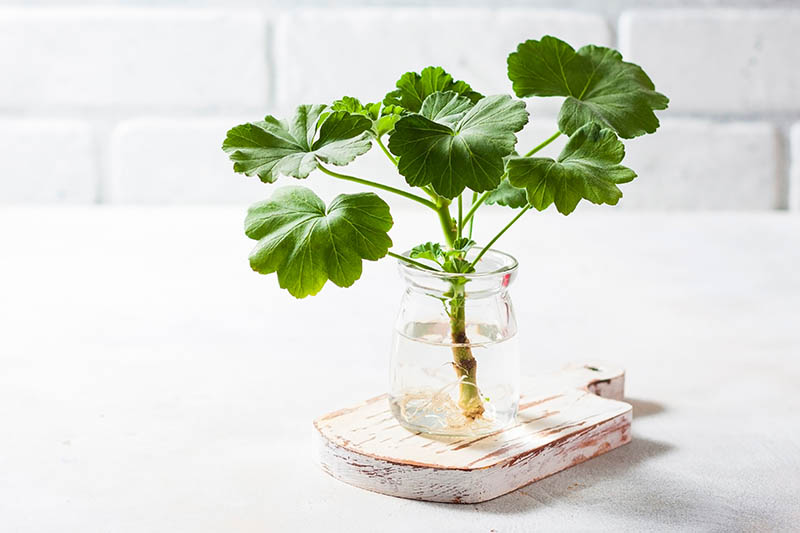
Fill the jar with enough water to cover the main stem, but not enough to touch the leaves.
Place on a sunny windowsill in a location that maintains an average temperature of 65-75°F.
Change the water daily to keep it fresh. After about four weeks, you should see roots developing at the bottom of the stem.
Rooting in Potting Medium
An alternative method is to use a sterile potting medium instead of water.
Choose a clean container with good drainage holes that is four to six inches deep.
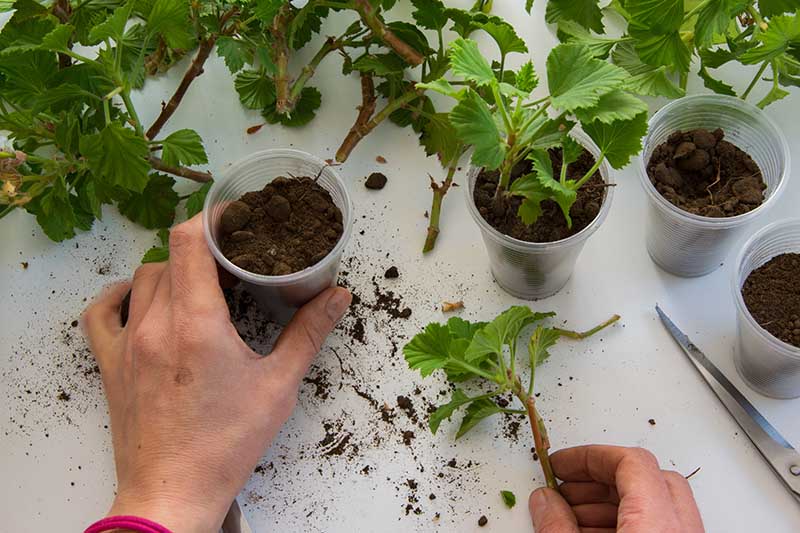
Fill the container with potting medium, to about one-half inch below the rim. If desired, you can dip the cut end of the stem into powdered rooting hormone.
Make a hole and place the stem into the potting medium, pushing it down far enough to cover all the places where leaves were removed, as roots will form from these leaf nodes.
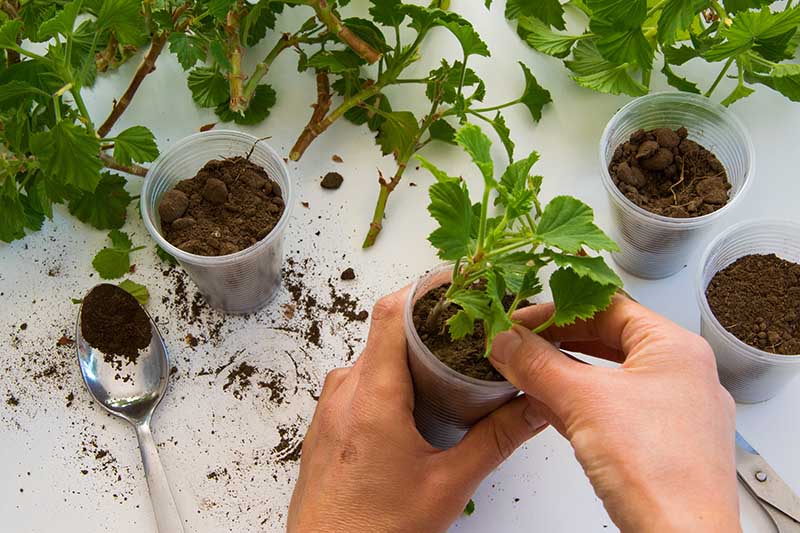
Firm the potting medium around the stem to anchor it firmly.
Water thoroughly and place in a location with an average temperature of 65-75°F and bright sunlight. You can use a heat mat and grow light if you wish.
Keep the potting medium lightly moist but never allow it to become soggy or to completely dry out.
Some folks like to create a mini greenhouse for a cutting by placing a clear plastic bag over the pot. This is a clever way to maintain the appropriate ambient temperature and moisture required.
If you choose this method, be sure not to seal the bag or expose the plant to direct sunlight or it may become overheated.
Transplanting
Once you see roots through the clear container, or new shoots on the stems growing in the potting medium, you’ll know that your cuttings are thriving.
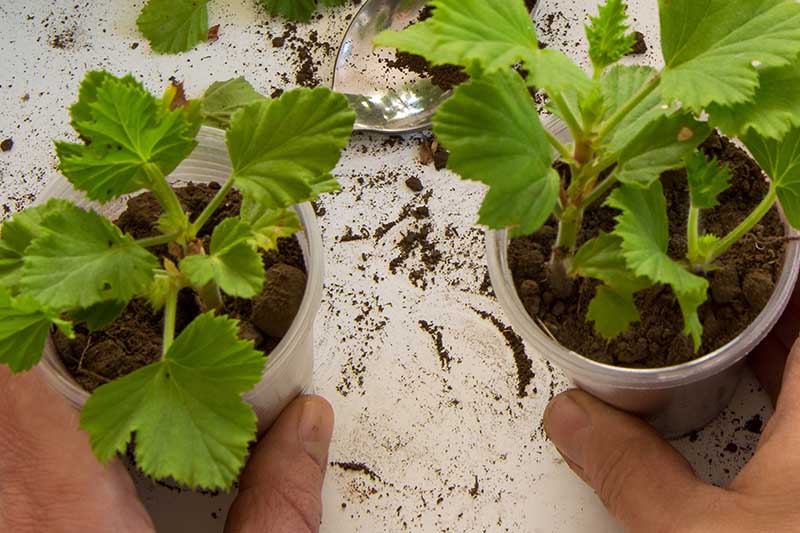
When the roots are one or two inches long, or you see new foliar growth in your potted cuttings, you can start the process of acclimating them to the outdoors, a process called hardening off.
If you took your cuttings in fall, make sure you wait until all risk of frost has passed.
Set the plants outside for a few hours each day for a week. Place them in a sheltered location at first, and gradually out in the open. Skip any days with inclement weather in the forecast.
At the end of the week, it’s time to complete the propagation process by planting your rooted and sprouted cuttings out into the garden.
Geraniums Galore
For those of us in the Northeast, like me, it’s economical to take cuttings from plants that we can only grow as annuals, thanks to our freezing winter temperatures.
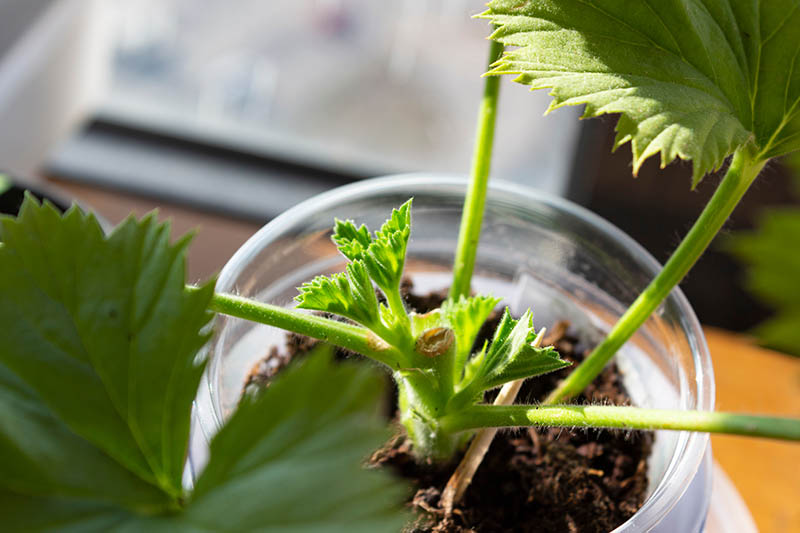
And it’s really fun to have a plant nursery indoors while the ground outside is frozen solid.
Give geranium propagation a try, and don’t be surprised when you can’t find enough sunny spots for all of your little plant babies!
Have you tried taking cuttings from your geraniums? Let us know in the comments below.
If you think you’d like to try your hand at plant propagation, you’ll enjoy reading these articles next:
- How to Grow Lavender from Cuttings
- Propagating Succulents in 5 Easy Steps
- Into the Cloning Vats: Easily Propagating African Violets
© Ask the Experts, LLC. ALL RIGHTS RESERVED. See our TOS for more details. Uncredited photos: Shutterstock.
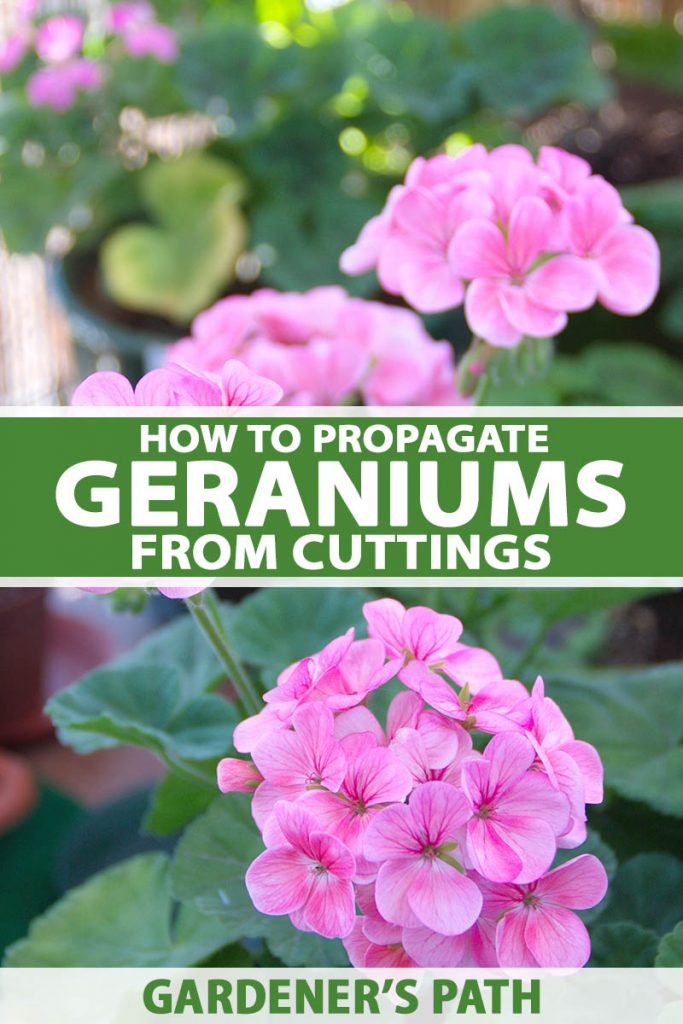



I have 16-year-old plants from cuttings first removed from my mother-in-law’s home garden when she moved to a retirement home. I had always admired the deep, intense red of her garden geraniums and continue to enjoy them summer after summer. It is a memory too for my wife.
Hello David –
The colors and fragrances of flowers are such a rich part of our sweet memories. Thank you for sharing.
I have grown geraniums for years and taken dozens of cuttings, especially of my favorites. But last year a nasty fungal disease hit my plants and did serious damage before I even noticed. I’m not really sure when I should spray. Any thoughts? Thanks
Hi Marsha –
The fungus Botrytis cinera can cause Botrytis blight of geraniums. The best way to avoid it is to space plants generously for ample air circulation, keep the garden weeded, avoid overwatering, and water the soil, not the leaves.
In the event of an outbreak, it’s crucial to remove and dispose of affected plant material in the trash, and sanitize garden tools to prevent spreading the disease.
Bonide RevitalizeBONIDE® Revitalize® Biofungicide from Arbico Organics may be an effective treatment.
Why are my geranium cuttings turning yellow after putting them in a cup of water a few days ago?
Hi Maureen –
It’s not unusual for the leaves to turn yellow as the plant’s energy is shifted from photosynthesis to root formation.
Make sure that no leaves are below the surface of the water and change the water daily. Keep the container on a sunny windowsill in a 65-75°F room.
If you made your cut just below a leaf node, which is a natural growing point, you should see root formation in about a month.
Several years ago I brought Geraniums of different colors indoors for the winter and took many stem cuts and grew roots. By the following spring our sunporch was alive with blooms. I went from 3 plants in the fall to an easy 15 plants by spring.
Hi Gus –
That’s terrific! You’ve got a green thumb. Thank you for sharing.
Hi there! Thank you for the detailed, informative post. I’m about to embark on propagating geraniums for the first time, and am really struggling as to whether I should root in water or soil. Do you have a preference for one method over the other? Or what factors could I consider when deciding between methods?
Thank you kindly 🙂
Hi Stefanie – We’re so glad you enjoyed the article. I prefer to root in water because I can watch the roots grow. Also, I have fewer concerns when I see a yellow leaf, because I don’t have to wonder if the stem is rotting where I can’t see it. Moving from water to soil may be more stressful than starting out in soil. Some folks recommend adding a little soil to the water to ease the transition. My suggestion is to try both methods and note the development of each cutting in a garden journal. We can’t wait to… Read more »
Wonderful, thank you so much for the feedback and suggestions! I appreciate it 🙂
I took cuttings of geraniums 2 days ago. Is it too late to pot them up or put in water to propagate? They look wilted
Hi Adele –
Great question! At this point, the cut stems are already beginning to form calluses. Examine them for signs of remaining moisture. When they are dry to the touch, you can pot them per the “Rooting in Potting Medium” section of the article.
I have a dry,bare stem w/ roots,I believe the plant was up lst year,I keep it by the window.How do I get it to do something?
Hello RedElisa Mendoza –
It sounds like your plant dried up in its pot. If the roots are still supple and not dried out and brittle, you may be able to salvage it by trimming the dead stem down to an inch above the crown, where the roots and stem meet. Then repot the remaining plant in fresh potting soil, and keep the soil evenly moist but not soggy. It’s a long shot, but it may work.
I live in the Mediterranean, we are cursed with the geranium butterfly every summer here. Any advise please.
Hello Carlota –
The geranium bronze butterfly, Cacyreus marshalli, poses quite a challenge to growers in your region. Treatment is challenging because the larvae are endophytes that live inside plant tissue. One that may be effective is Bacillus thuringiensis, Bt. You can read about Bacillus thuringiensis in our article.
Loved the article!
Hi Jane –
We’re so glad to hear this! Thank you for your feedback.
All of my stems seem to be more of the hardened, woody type. Can I still use one to propagate?
Hi Shauna –
Soft cuttings are the most likely to root, but you can try it with woody stems.